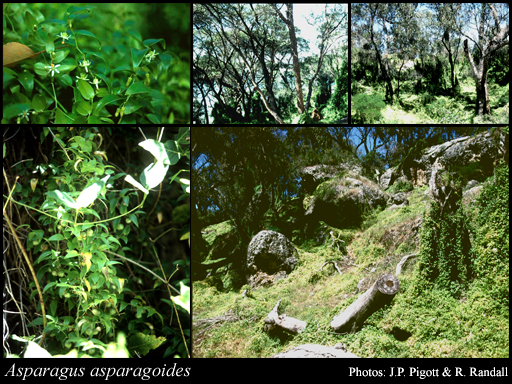- Reference
- Rep.Bot.Exch.Club Brit.Isles 3:414 (1914)
- Conservation Code
- Not threatened
- Naturalised Status
- Alien to Western Australia
- Name Status
- Current
Rhizomatous and tuberous, perennial, herb and climber, 1-5 m high. Fl. white, Aug to Sep. Sand, loam, clay, granite.







Distribution
- IBRA Regions
- Avon Wheatbelt, Coolgardie, Esperance Plains, Geraldton Sandplains, Jarrah Forest, Mallee, Swan Coastal Plain, Warren.
- IBRA Subregions
- Dandaragan Plateau, Eastern Mallee, Fitzgerald, Katanning, Lesueur Sandplain, Mardabilla, Merredin, Northern Jarrah Forest, Perth, Recherche, Southern Cross, Southern Jarrah Forest, Warren, Western Mallee.
- IMCRA Regions
- Central West Coast, Leeuwin-Naturaliste, WA South Coast.
- Local Government Areas (LGAs)
- Albany, Augusta Margaret River, Beverley, Bunbury, Capel, Cockburn, Collie, Coorow, Corrigin, Cottesloe, Cranbrook, Cuballing, Dardanup, Denmark, Donnybrook-Balingup, Dumbleyung, Dundas, Esperance, Gingin, Gnowangerup, Harvey, Jerramungup, Mandurah, Manjimup, Melville, Nannup, Narrogin, Nedlands, Northam, Pingelly, Plantagenet, Ravensthorpe, Rockingham, Serpentine-Jarrahdale, Swan, Tammin, Wanneroo, Wickepin, Williams, Yilgarn.
Management Notes (for the Swan NRM Region)
Alternative Names. Bridal Creeper, Florists' Smilax.
General Biology. Growth form. Geophyte. Life form. Perennial rhizome/tuber. Reproduction. Primarily seed, occasionally rhizome/tubers. Dispersal. Birds, foxes, rabbits, water, soil, machinery, garden refuse. Time to first flowering. 2-3 years. Seedbank persistence. 2-3 years if buried. Fire response. Generally survives fire.
Notes. Biocontrol agents include a leafhopper, a rust fungus and a leaf beetle. Extremely invasive, smothers vegetation, forms monocultures, increases fire risk during summer die-off phase.
Additional information. Origin. South Africa. History of use/introduction. Garden escape. First recorded in Australia in 1857 and by 1870s was a common garden plant.
Suggested method of management and control. Spray 0.2 g metsulfuron methyl + Pulse® in 15 L water (or 2.5 - 5g /ha + Pulse®). Best results achieved when flowering. Biological control agents available. Read the manufacturers' labels and material safety data sheets before using herbicides. For further information consult the Australian Pesticides and Veterinary Medicines Authority to determine the status of permits for your situation or state.
Management Calendar
| Calendar Type | Jan | Feb | Mar | Apr | May | Jun | Jul | Aug | Sep | Oct | Nov | Dec | Comments |
|---|---|---|---|---|---|---|---|---|---|---|---|---|---|
| Dormant | Y | Y | Y | Y | |||||||||
| Active Growth | O | Y | Y | Y | Y | Y | Y | Y | Y | O | |||
| Flowering | Y | Y | |||||||||||
| Germination | Y | Y | Y | Y | Y | Y | Y | ||||||
| Optimum Treatment | Y | Y |
Legend: Y = Yes, regularly, O = Occasionally, U = Uncertain, referred by others but not confirmed.
References
- Brown, K. & Brooks, K. (2002) Bushland Weeds: A Practical Guide to their Management. Environmental Weeds Action Network, Greenwood.
- Hussey, B.M.J., Keighery, G.J., Dodd, J., Lloyd, S.G. & Cousens, R.D. (2007) Western Weeds. A guide to the weeds of Western Australia. 2nd Edition. The Plant Protection Society of Western Australia, Victoria Park.
- Moore, C.B. & Moore, J.H. (2002) Herbiguide, the pesticide expert on a disk. Herbiguide, PO Box 44 Albany, Western Australia, 6330.
- Pritchard, G.H. (2002) Evaluation of herbicides for the control of the environmental weed bridal creeper. Plant Protection Quarterly, 17 (1): 17-27.
- Raymond, K. (1996) The ecology of bridal creeper in south-eastern Australia. In Proceedings of the Bridal Creeper Symposium (eds. J.P. Pigott, D.L. Lamont & G.J. Keighery). Plant Protection Quarterly, 11 (2): 47.
- Stansbury, C.D. (1999) The invasiveness and biogeographical limits of the environmental weeds Bridal Creeper, Asparagus asparagoides, and Bridal Veil, A. declinatus, in south-western Australia. Ph.D Thesis, University of Western Australia, Perth.
- Stansbury, C.D. (2001) Dispersal of the environmental weed Bridal Creeper, Asparagus asparagoides, by Silvereyes, Zosterops lateralis, in south-western Australia. Emu, 101: 39-45.
- The National Asparagus Weeds Committee (2006) Asparagus Weeds; Best Practice Management Manual. Department of Water, Land and Biodiversity Conservation, Government of South Australia URL: http://www.weeds.org.au/WoNS/bridalcreeper/ - Accessed June 2008.
- Turner, P. J. & Virtue, J. G. (2009) Ten year post-fire response of a native ecosystem in the presence of high or low densities of the invasive weed, Asparagus asparagoides. Plant Protection Quarterly, 24 (1): 20-26.
- Turner, P.J., Scott. J. K. & Spafford, H. (2008) The ecological barriers to the recovery of bridal creeper (Asparagus asparagoides (L.) Druce) infested sites: Impacts on vegetation and the potential increase in other exotic species. Austral Ecology, 33 (6): 713-722.
- Willis, A.J. (2000) Best practice management guide, Bridal creeper, Asparagus asparagoides. CRC for Weed Management Systems, Canberra. URL: http://www.weedscrc.org.au/documents/bridal_creeper.pdf - Accessed December 2007.